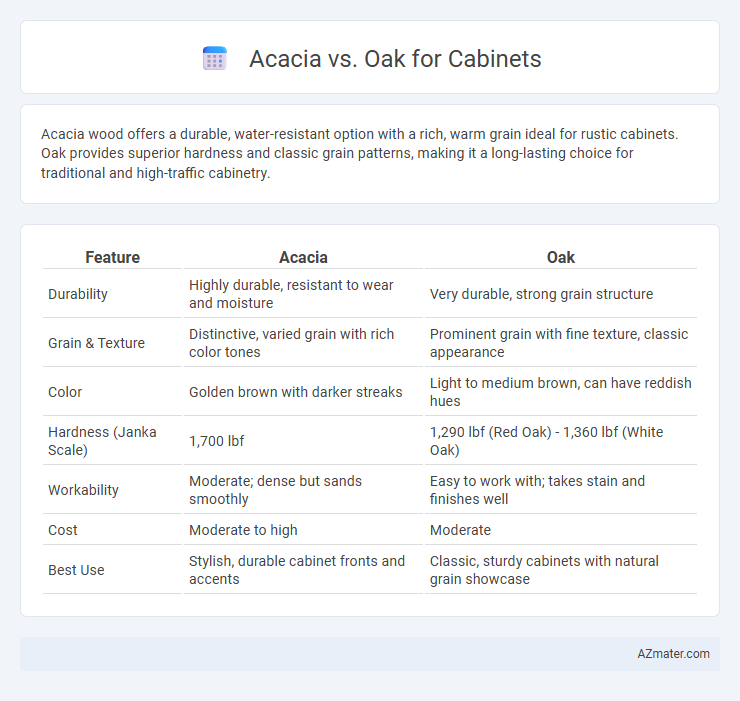Acacia wood offers a durable, water-resistant option with a rich, warm grain ideal for rustic cabinets. Oak provides superior hardness and classic grain patterns, making it a long-lasting choice for traditional and high-traffic cabinetry.
Table of Comparison
| Feature | Acacia | Oak |
|---|---|---|
| Durability | Highly durable, resistant to wear and moisture | Very durable, strong grain structure |
| Grain & Texture | Distinctive, varied grain with rich color tones | Prominent grain with fine texture, classic appearance |
| Color | Golden brown with darker streaks | Light to medium brown, can have reddish hues |
| Hardness (Janka Scale) | 1,700 lbf | 1,290 lbf (Red Oak) - 1,360 lbf (White Oak) |
| Workability | Moderate; dense but sands smoothly | Easy to work with; takes stain and finishes well |
| Cost | Moderate to high | Moderate |
| Best Use | Stylish, durable cabinet fronts and accents | Classic, sturdy cabinets with natural grain showcase |
Introduction: Acacia vs Oak for Cabinetry
Acacia and oak are two popular hardwood choices for cabinetry, each offering unique characteristics that impact durability, aesthetics, and maintenance. Acacia wood is known for its rich, warm hues and striking grain patterns, making it a favored option for contemporary and rustic designs. Oak, prized for its strength and classic look, features a prominent grain and light to medium brown color, providing timeless appeal and long-lasting performance in cabinetry.
Wood Characteristics: Acacia and Oak Compared
Acacia wood is known for its rich, warm hues and distinctive grain patterns, offering a dense, durable surface that resists scratches and moisture well, making it ideal for cabinets in high-use areas. Oak, characterized by its prominent grain and lighter color variations, provides exceptional strength and a classic, timeless appearance, favored for its resistance to wear and warping over time. Both woods offer durability, but Acacia's natural oils enhance water resistance, while Oak's hardness contributes to longevity and structural integrity in cabinetry.
Durability and Hardness: Which Wood Lasts Longer?
Acacia wood boasts a Janka hardness rating of about 1,070, making it highly durable and resistant to daily wear and scratches, ideal for long-lasting cabinetry. Oak, particularly red oak, has a Janka rating around 1,290, which is slightly harder than acacia, offering superior resistance to dents and impacts over time. Both hardwoods provide excellent longevity for cabinets, but oak tends to last longer in high-traffic areas due to its greater hardness and density.
Grain Patterns and Aesthetics
Acacia wood features a rich, varied grain pattern with distinct swirls and contrasting colors, providing a warm, exotic appearance for cabinets. Oak has a more uniform and pronounced grain with straight lines and occasional knots, offering a classic, timeless look that suits traditional and modern designs. The choice between Acacia and Oak for cabinets depends on whether you prefer bold, dramatic textures or consistent, elegant grain aesthetics.
Color Variations: Acacia vs Oak Cabinets
Acacia cabinets display a rich spectrum of color variations, ranging from creamy whites and golden browns to deep reddish hues, offering a warm, exotic aesthetic. Oak cabinets, on the other hand, typically feature lighter tones such as pale beige and honey, as well as darker shades like medium brown or red oak, providing a classic, timeless appeal. The distinct color variations in Acacia create a more dramatic and rustic look, while Oak's color palette enhances traditional and versatile cabinetry styles.
Workability and Ease of Installation
Acacia wood offers superior workability for cabinet making due to its moderate hardness and smooth grain, allowing easy cutting, shaping, and finishing compared to the denser, harder oak. Oak's high density and pronounced grain can pose challenges during installation, often requiring specialized tools and careful handling to avoid splitting or warping. Both woods provide durable cabinets, but acacia's lighter weight enhances ease of installation, reducing labor time and effort on-site.
Maintenance and Care Requirements
Acacia cabinets require regular oiling to maintain their rich color and prevent drying, while oak cabinets need periodic sealing to protect against moisture and staining. Both woods benefit from cleaning with a soft, damp cloth but harsh chemicals should be avoided to preserve the wood finish. Acacia's natural oils provide some resistance to pests and decay, whereas oak's dense grain offers robust durability but demands more attention to avoid surface scratches and water damage.
Cost Comparison: Acacia vs Oak Cabinets
Acacia cabinets generally cost less than oak due to the faster growth rate and wider availability of acacia wood, making it a budget-friendly option for homeowners. Oak cabinets, known for their durability and classic grain patterns, often carry a higher price tag but offer long-term value through enhanced longevity and resistance to wear. Choosing between acacia and oak hinges on balancing upfront costs with desired aesthetics and durability for cabinetry projects.
Environmental Impact and Sustainability
Acacia wood, often sourced from fast-growing trees, offers a more sustainable option for cabinets due to its rapid regeneration and lower deforestation risk compared to oak, which grows slower and requires mature forests that are less renewable. Oak cabinets, while durable and popular, often contribute to habitat loss and higher carbon footprints because of longer growth periods and intensive harvesting practices. Using Acacia supports eco-friendly furniture production by minimizing resource depletion and promoting responsible forest management.
Which Wood is Best for Your Cabinet Project?
Acacia and oak both offer durable, attractive options for cabinet projects, but choosing the best wood depends on your specific needs and style preferences. Acacia wood is known for its rich, varied grain patterns and natural resistance to moisture, making it ideal for cabinets in humid areas like kitchens and bathrooms. Oak provides a classic, uniform grain with superior hardness and longevity, perfect for traditional or rustic cabinetry that requires strength and a timeless appeal.

Infographic: Acacia vs Oak for Cabinet
 azmater.com
azmater.com